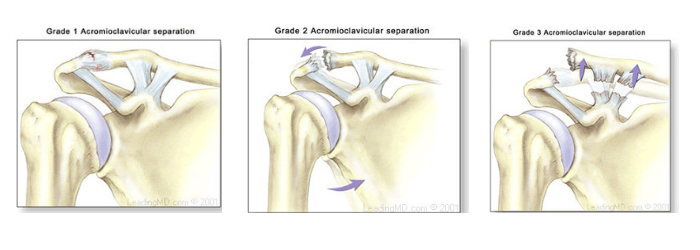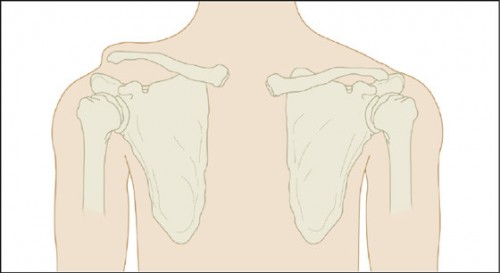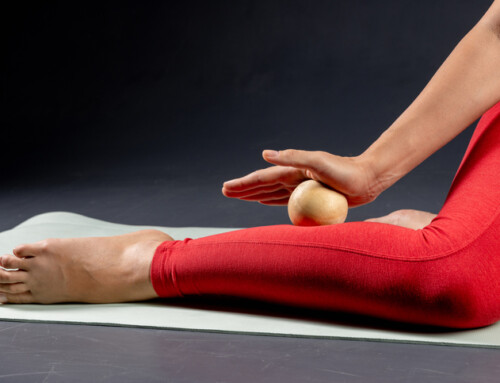AC Joint Sprain
Shoulder injuries are extremely common in both contact and non-contact sports. An injury to the AC joint is commonly referred to as a “separated shoulder”. This is different from a dislocated shoulder, which is an injury to the glenohumeral joint.

(Retrieved from: https://www.thesteadmanclinic.com/patient-education/shoulder/ac-separation)
What is an AC Joint Sprain?
An AC joint sprain is an injury to the acromioclavicular ligament, the ligament that joins the shoulder blade (scapula) and collar bone (clavicle). It can also involve the coracoclavicular ligament, which also holds the shoulder blade and collarbone together. Separated shoulder – or AC joint sprains – like most other ligament sprains, are classified in three grades – I, II, and III – based on the amount of over-stretching or tearing that has occurred in the ligament.
Sprain Classifications
- Grade I sprain – the lowest severity, involves partial tearing of the AC ligament.
- Grade II sprain – full tearing of the AC ligament and partial tearing of the CC ligament
- Grade III sprain – full tearing of the AC ligament as well as the tearing of the CC ligament.

(Retrieved from: https://www.thesteadmanclinic.com/patient-education/shoulder/ac-separation)
AC joint sprains can occur in any sport or activity and can happen in both contact and non contact sports. A very common way that this injury occurs in contact sports is from a direct blow to the shoulder, like from a body check – force transfers through the shoulder joint and disrupts the connection between the clavicle and acromion, tearing the ligament. Common ways that this injury occurs in non contact sports is through FOOSH – fall on an outstretched hand, or from falling directly on to your shoulder.
Signs and Symptoms of Separated Shoulder
Regardless of the method of injury, it is common to feel a ‘pop’ on the top of the shoulder and sharp pain. Swelling and bruising may develop, as well as tenderness over the joint and on the top of the shoulder. Moving the arm across the midline of the body towards the opposite shoulder and raising the arm above shoulder height usually causes pain over the joint. Depending on the grade of injury a “step deformity” may be present – named because it looks like a step on the top of the shoulder. Unless surgically repaired the deformity is permanent – it is very easy to spot basketball players who have experienced this injury since their uniforms do not cover the AC joint – next time you’re watching a game see if you can spot one.

Retrieved from: https://aneskey.com/ acromioclavicular-shoulder-separation/
It is possible to fracture the clavicle (collarbone) in addition to spraining your AC joint so its important to have this injury properly evaluated by a healthcare professional to rule out additional complication
Treatment For AC Joint Sprains
Treatment for isolated AC joint sprains depends on the grade. Patients are usually placed in a sling initially, and reducing pain is the one of the first priorities. Ice is always recommended, and your physical therapist may use some modalities to try and control the pain.
- A grade I sprain usually takes 1-3 weeks to fully heal, but it may be possible to continuing participating in sport with a grade I sprain with the help of padding and taping.
- A grade II sprain takes 3-6 weeks to heal and requires full rest at the start of treatment. Both grade I and II follow the same treatment outline – regaining full range of motion and strength in the rotator cuff, chest, and upper arm are critical for healing and preventing a re-occurrence. After basic strength and range have been restored, dynamic and sport specific exercises are added in. Taping and padding may be used to protect the area and support the joint when returning to sport.
- A grade III sprain may require surgery depending on the displacement of the clavicle, but will follow the same treatment outline as above post-surgery.
Prevention for Separated Shoulder
Once you’ve experienced an AC joint injury, it is very important to fully rehab the shoulder to prevent a re-occurrence. Strengthening the shoulder is important, but making sure you warm up before activity is equally as important – maintaining mobility around the shoulder joint needs to be addressed. In sports that require equipment, make sure the shoulder joint is adequately protected and that your equipment fits the way it should – if it doesn’t cover the AC joint its not doing its job and needs to be resized or replaced. And finally, proper posture and avoiding slumping, which is important for everyone, will help keep unneeded stress off the shoulder joint.
If you have experienced an injury like separated shoulder and need an experienced physical therapy professional, call us at 518-289-5242 to reach our Queensbury, Malta – Saratoga, or Latham PT clinics. Ask us how we can help provide more information on injury prevention and treatment for AC joint injuries in Saratoga Springs, Ballston Spa, Glens Falls , Queensbury, Latham, Troy and Albany NY regions.





